Reposted from Polar Bear Science
Posted on May 10, 2021 |
The beginning of this month was the 15th anniversary of the day the IUCN declared polar bears ‘vulnerable’ to extinction because of climate change, the first time such a designation had ever been made. It was based on the opinion of polar bear specialists who examined the vague information available at the time and decided that in 45 years the bears might be in serious trouble. This decision changed the way the IUCN assessed species risk and led to mass confusion for the general public, who falsely assumed polar bear numbers had already declined by a huge amount.
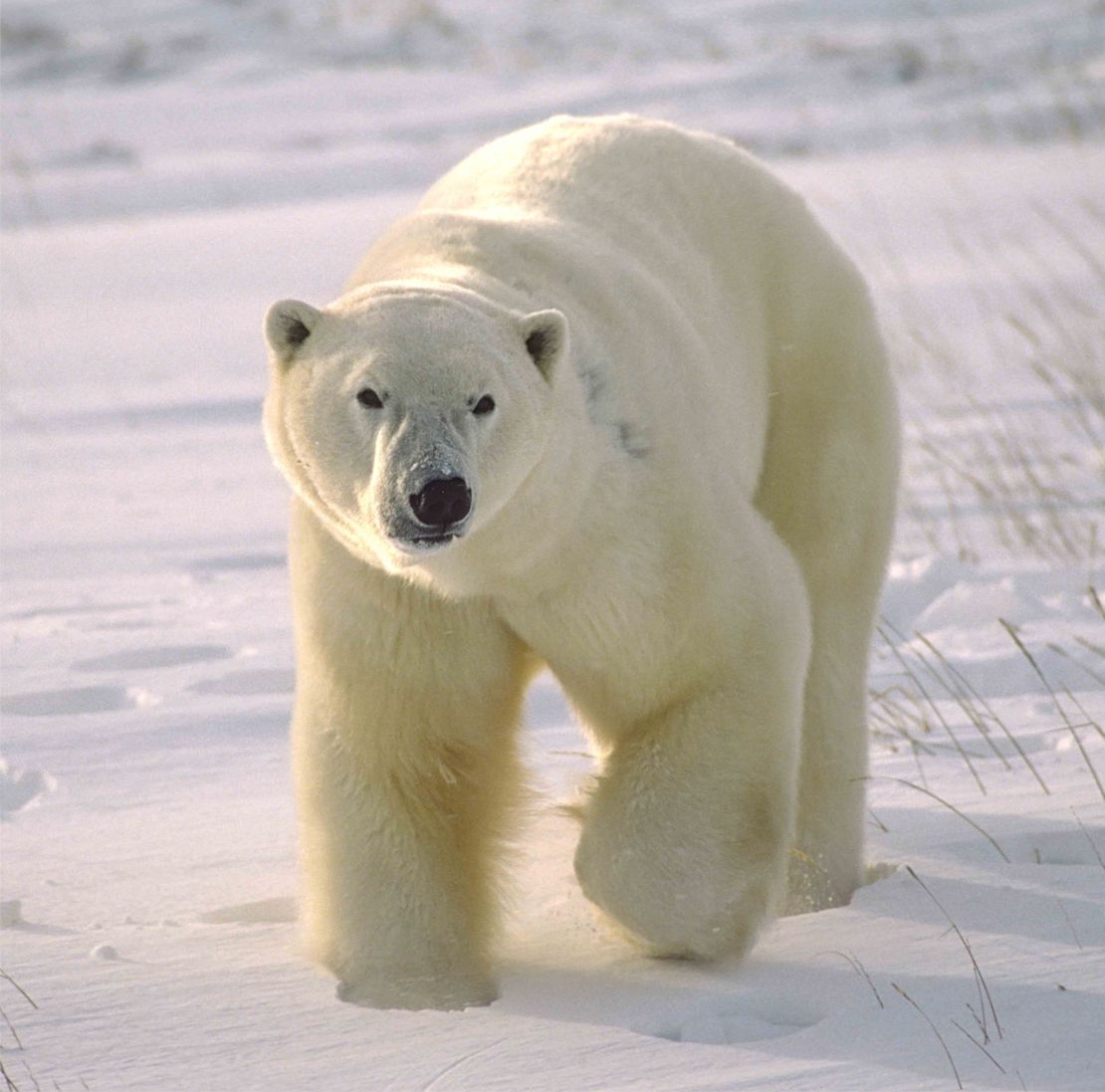
The Polar Bear Specialist Group was created in 1968 as a unit of the International Union for the Conservation of Nature (the IUCN), who had just developed a “Red List” of threatened and endangered species. The PBSG negotiated the 1973 International treaty to protect polar bears from unregulated hunting, a very real threat they’d been subjected to for decades.
Polar bears were first listed in 1982 as ‘vulnerable’ by the IUCN – a category equivalent to ‘threatened’ in the US. They remained in that category until 1996, when it became clear that polar bear numbers had recovered substantially. Due to the population rebound, polar bear status changed to ‘lower risk’ in 1996 (now known as ‘least concern’) and it remained there for 10 years: polar bears had been saved.
PBSG members were clearly not happy that polar bears no longer qualified as ‘vulnerable’ (this is apparent in their meeting reports) so in 2005, they recommended to the IUCN that polar bears be uplisted back to ‘Vulnerable’ on the basis of population declines expected to follow from modeled sea ice loss due to expectations of global warming (see below, from the ACIA 2005 report). Although this assessment merely reflected the opinion of PBSG members of what might happen in the future, it was accepted by the IUCN in 2006 as if it were supported by a detailed scientific analysis (Aars et al. 2006; Crockford 2017, 2019).
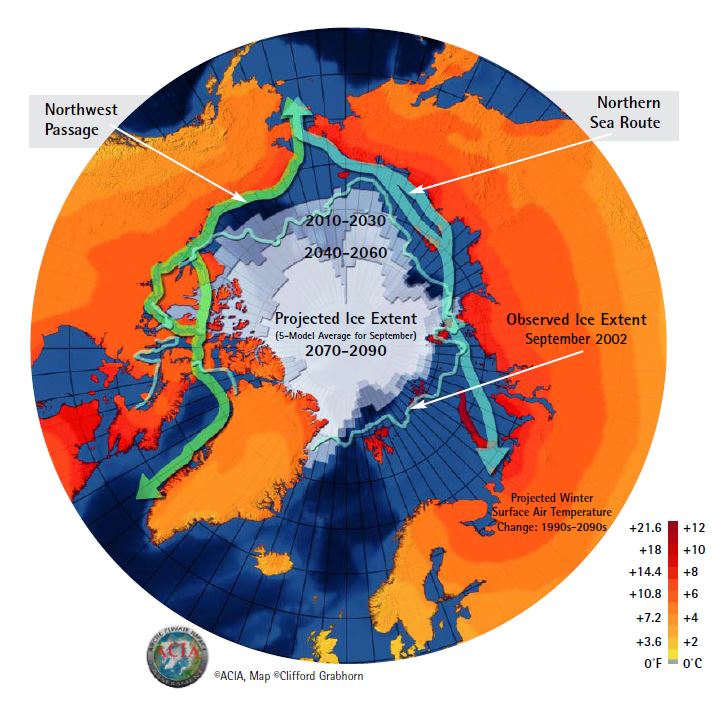
Without a shred of irony, on 1 May 2006 the IUCN reported two familiar animals among 530 added to the list of endangered species that year: the polar bear, based on the opinion of scientists, informed by climate models, that their numbers would decline by more than 30% over the next 45 years and the common hippo, based on an actual decline of more than 95% in the Congo. Both were to be listed as ‘vulnerable’ – one based on facts of a catastrophic local decline and the other based on prophesy.
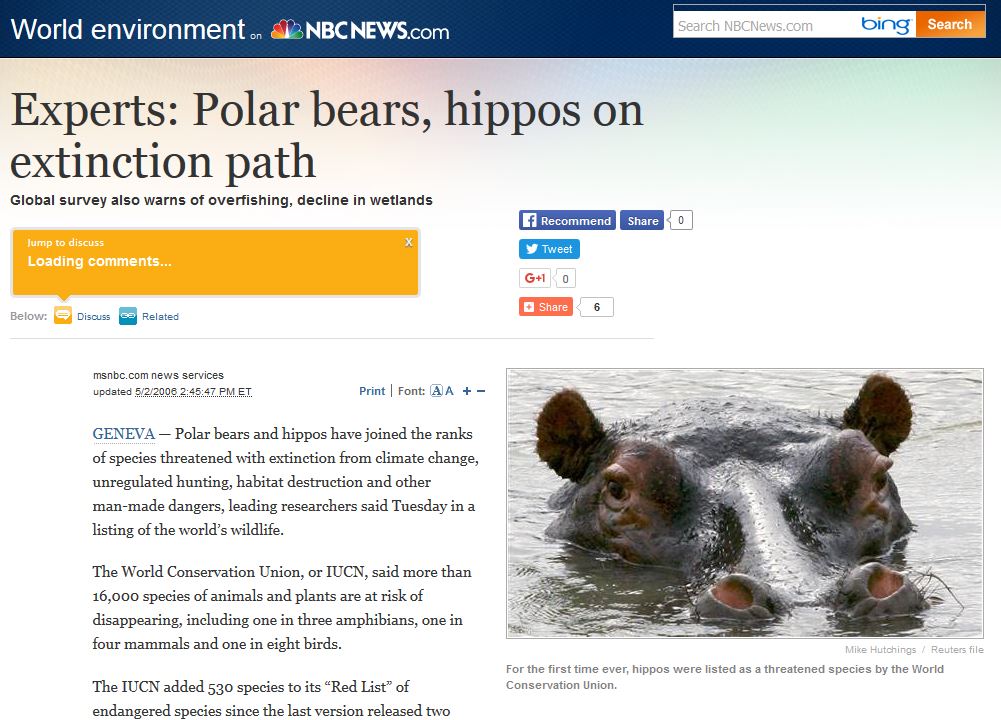
Using ‘future threats’ based on climate models to declare a species threatened with extinction had never been done before – by the IUCN or anyone else. Here are some of the stories from that eventful time:
Fossil fuel addiction driving polar bears to extinction says WWF-Canada (WWF, 4 May 2006)
Polar bears gain ‘vulnerable’ status on world list of endangered species (CBC, 1 May 2006)
Polar bears sink deeper into danger (NATURE News, 2 May 2006)
One reason behind the PBSG decision to uplist polar bears to the ‘Vulnerable’ category was undoubtedly the knowledge that in early 2005, three activist environmental groups (Center for Biological Diversity, Greenpeace, and Natural Resources Defense Council) filed a petition to list polar bears as threatened under the US Endangered Species Act (the ESA). Later that year, the groups sued the US government for failing to address their concerns within the time frame required under ESA rules.
Now that they knew it could be done, in 2007 American biologists at the US Geological Survey (the USGS) used the IUCN “future threats” strategy to support the prediction that polar bears would be threatened with extinction within 3 polar bear generations or 45 years due to predicted sea ice loss (Amstrup et al. 2007). This time they made a model to support their opinions but it was a particular kind of model that could treat opinions as if they were facts (a ‘Bayesian’ model). I have shown that their prediction (that 2/3 of the world’s polar bears would disappear when sea ice dropped by about 40% and stayed there for 10 years – which was not expected to occur until 2050 but instead happened in 2007) failed in rather spectacular fashion (Crockford 2017, 2019; Crockford and Geist 2018).
In 2015, the IUCN commissioned another assessment and this time, they not only demanded that a mathematical model be used to predict future declines but that facts rather than opinions be used: a Bayesian model would not be acceptable. The official global population estimate used by the IUCN in 2015 was 22,000-31,000 (or an average of 26,000) and the worst they could predict for the future was that by 2050, there was a 70% chance that the population would decline by 30% or more (Wiig et al. 2015; Regehr et al. 2016). They did not acknowledge that a 30% decline for most modern population counts would not even be statistically significant (Crockford 2020:15). In addition, they underplayed the fact that they had simply assumed summer sea ice would continue to decline in a linear fashion: no climate sea ice models were actually utilized.
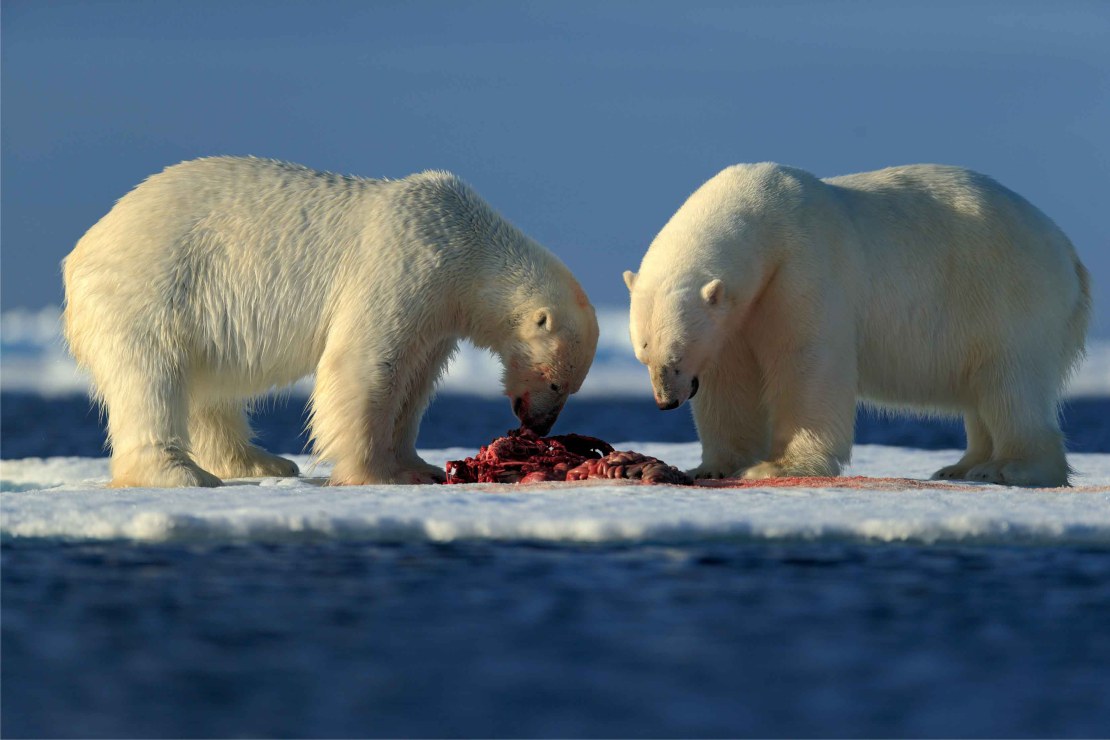
Now, in 2021, polar bear numbers are the highest they’ve been in 60 years. Recent survey results would put the global average at about 30,000 (Crockford 2021): up a little from 26,000 but not by a significant amount. However, a plausible argument can be made that this number is likely to be much higher – possibly as high as 58,000 (Crockford 2017, 2019, 2020:3).
Red List status for polar bears in 2006 provided employment for biologists and increased donations for conservation charities but nothing for the bears that the international treaty in 1973 hadn’t already done. Protection from over-hunting was what the bears needed: most populations are still recovering from the wanton slaughter that started more than a century ago.
In other words, I don’t see any positive effect on the bears from being listed by the IUCN: they were already well protected by national laws and international treaties put in place before 2006. The concern for future polar bear survival was always about predicted low sea ice levels in the future but even after 15 years of moderately low summer sea ice (about 40% less than 1979) we have not yet seen any species-wide effects that can be attributed conclusively to climate change.
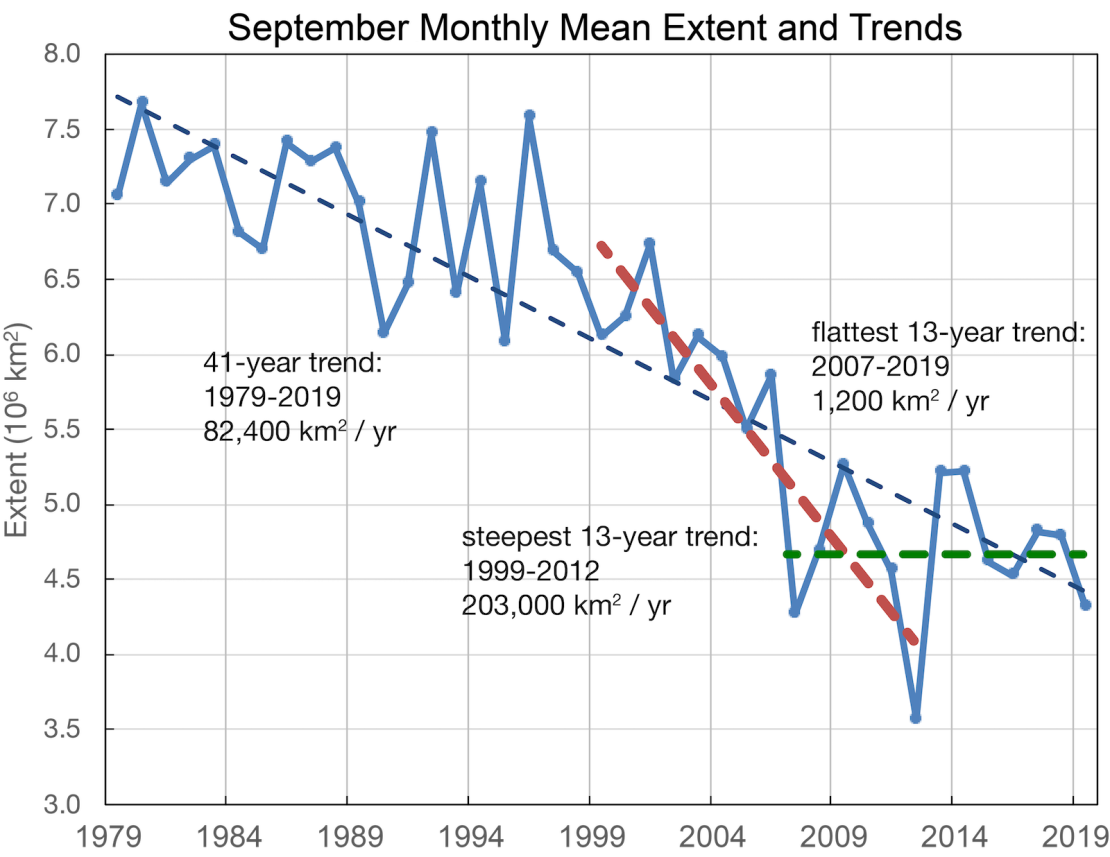
What we’ve learned over the last 15 years is that polar bears only require sea ice until about mid-May or mid-June (depending on the latitude) and again in the late fall (November) through the winter. As long as ice is present at those times the bears will be fine. The idea that summer sea ice is essential for polar bear survival was an early assumption made by polar bear specialists that turned out to be wrong.
As I explained in my book, The Polar Bear Catastrophe That Never Happened, if polar bears really required as much summer ice as IUCN biologists assumed back in 2006, there would be fewer than 10,000 bears remaining – and that simply didn’t happen.
Climate change is unlikely to effect the future of polar bears unless there is much less ice by mid-May, which does not look likely to happen any time soon based on current conditions (see below):
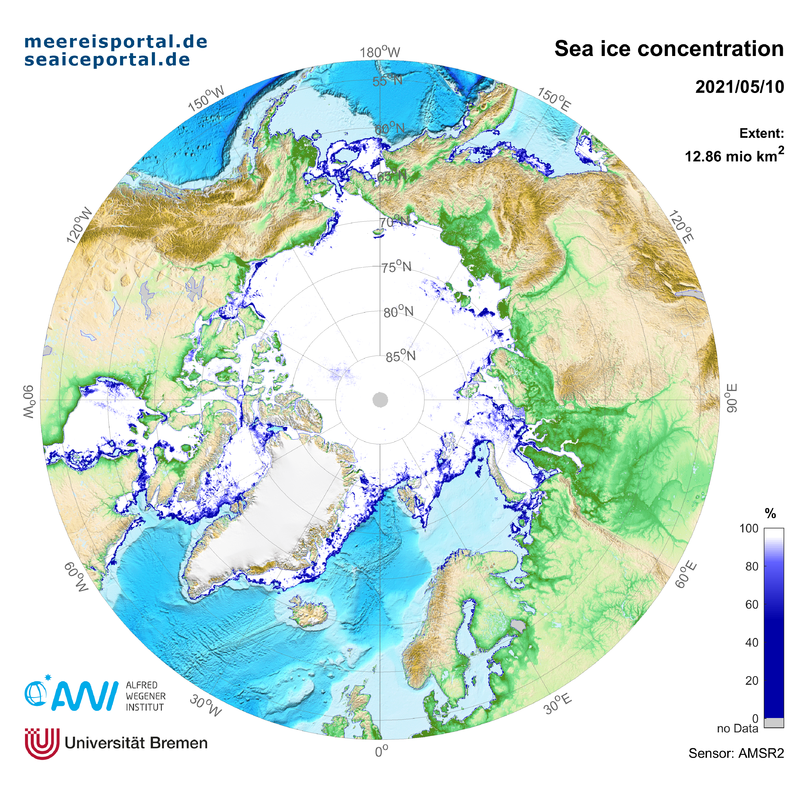
References
Aars, J., Lunn, N. J. and Derocher, A.E. (eds.) 2006. Polar Bears: Proceedings of the 14th Working Meeting of the IUCN/SSC Polar Bear Specialist Group, 20-24 June 2005, Seattle, Washington, USA. Occasional Paper of the IUCN Species Survival Commission 32. IUCN, Gland (Switzerland) and Cambridge (UK). http://pbsg.npolar.no/en/meetings/
ACIA 2005. Arctic Climate Impact Assessment: Scientific Report. Cambridge University Press. See their graphics package of sea ice projections here.
Amstrup, S.C., Marcot, B.G. & Douglas, D.C. 2007. Forecasting the rangewide status of polar bears at selected times in the 21st century. US Geological Survey. Reston, VA. Pdf here
Crockford, S.J. 2017. Testing the hypothesis that routine sea ice coverage of 3-5 mkm2 results in a greater than 30% decline in population size of polar bears (Ursus maritimus). PeerJ Preprints 19 January 2017. Doi: 10.7287/peerj.preprints.2737v1 Open access. https://peerj.com/preprints/2737/
Crockford, S.J. 2019. The Polar Bear Catastrophe That Never Happened. Global Warming Policy Foundation, London. Available in paperback and ebook formats.
Crockford, S.J. 2020. State of the Polar Bear Report 2019. Global Warming Policy Foundation Report 39, London. pdf here.
Crockford, S.J. 2021. The State of the Polar Bear Report 2020. Global Warming Policy Foundation Report 48, London. pdf here.
Crockford, S.J. and Geist, V. 2018. Conservation Fiasco. Range Magazine, Winter 2017/2018, pg. 26-27. Pdf here.
Regehr, E.V., Laidre, K.L, Akçakaya, H.R., Amstrup, S.C., Atwood, T.C., Lunn, N.J., Obbard, M., Stern, H., Thiemann, G.W., & Wiig, Ø. 2016. Conservation status of polar bears (Ursus maritimus) in relation to projected sea-ice declines. Biology Letters 12: 20160556. http://rsbl.royalsocietypublishing.org/content/12/12/20160556 Supplementary data here.
Wiig, Ø., Amstrup, S., Atwood, T., Laidre, K., Lunn, N., Obbard, M., et al. 2015. Ursus maritimus. The IUCN Red List of Threatened Species 2015: e.T22823A14871490. Available from http://www.iucnredlist.org/details/22823/0 [accessed Nov. 28, 2015]. See the supplement for population figures.
The sea ice in the Kara Sea and north of Svalbard appear increased compared with a few years ago.
And that is one mighty fat bear.
Yes, right now they do… this year has seen exceptional ice mobility over the last 2 months which has put ice there not seen in recent years at this time. But it is thin, mobile ice, likely to break up and it is there because it got blown in there, not because it froze there
Griffter, go there and inspect the situation…carry some meat for the bears.
Without going into too much complex detail, the most accurate rebuttal to your ideas is … NONSENSE!
The unusual clouds over Europe today are exceptionally thin mobile clouds, likely to soon clear. They were formed over the Atlantic Ocean and got blown in here, not because they condensed here
Answer one question, why does the number of polar bear increase ?
Seems, they feel good, in contrast to what you try to claim.
“But it is thin, mobile ice, likely to break up….”
You forgot the rest of the sentence griff. “….and if the ice breaks up while the bear is on it, the bear will drown.”
Thanks Griff for confirming my apparently correct observation.
At some point the numbers of bears will exceed the supply of seals to supply food for the predators diet. YouTube has some graphic videos of bears eating seals alive. Then when the seals run out the bears will starve. Maybe an ideal ratio could be maintained through bear hunting before that point is reached.
The more bears, the less seals, the more fish on which seals feed, the more fish for fishermen to supply for FOOD for humans.
Hunting bears MAY be a bad thing for humans, less those who live near the bears and may be killed by them.
Having watched Humpback whales feeding off of Cape Cod, them blowing an air ring to concentrate a school of fish, then breaching with a mouth full of the fish, one Humpback eats a lot of fish. Fish that could otherwise be for humans to eat.
I am not against “biodiversity”, it just seems to me that no one does studies that analyze the effect of apex predators, or predators in general on the totality of food stuffs for humans, the ultimate apex predator.
A friend in Nevada, when discussing mountain lion hunt restrictions in various states, mentioned that they ate an average of one deer a week, 52 a year. (I did no research to verify that.) Hunting mountain lions allowed for more dear hunting by humans. MOST hunters, myself included, actually use the harvested animals for food.
But envirowacos don’t really care about the WHOLE picture, thus their support of bird choppers and square miles of solar panel deserts created in forests on the east coast.
Drake you state that “it just seems to me that no one does studies that analyze the effect of apex predators, or predators in general on the totality of food stuffs for humans, the ultimate apex predator.”
well in fact there are plenty of such studies. Let start with the most obvious one that the number of calories produced each year is significantly more than what is needed to feed every human on the planet. In 2013 the average number of kcalories per person per day produced was 2800 (https://ourworldindata.org/food-supply) or in other words enough to make everybody obese if it was fairly distributed. Apex predators take a tiny fraction of that.
“Assumption…made by specialists…was wrong”. Really about all you needed for this one.
Assumptions made by specialists and applauded by alarmists and envirowackdoodles was and is wrong…
It all looks like very bad news for the seal population! Where’s the IUCN when you need it?
It’s certainly very bad news for Griff’s credibility.
Wait, Griff had credibility at one point? Every single thing I’ve seen him spout is demonstrably wrong.
Extinction is a Latin-based word meaning there are more and more of the creatures out there.
Off topic- sorry, but the latest post, in RealClimate:
“Why is future sea level rise still so uncertain?” by Gavin Schmidt
https://www.realclimate.org/index.php/archives/2021/05/why-is-future-sea-level-rise-still-so-uncertain/
It starts with:
“Three new papers in the last couple of weeks have each made separate claims about whether sea level rise from the loss of ice in West Antarctica is more or less than you might have thought last month and with more or less certainty. Each of these papers make good points, but anyone looking for coherent picture to emerge from all this work will be disappointed. To understand why, you need to know why sea level rise is such a hard problem in the first place, and appreciate how far we’ve come, but also how far we need to go.”
Later, I see:
“Back in 2015, Pollard et al. (2015) found that their ice sheet model was overall too stable in that it wasn’t able match the large sea level changes that have been inferred for the Eemian 125,000 yrs ago (6 to 9 meters). They added two destabilizing mechanisms, hydrofacturing of ice shelves and something called marine-ice cliff instability (MICI) and tuned the parameters to match the Eemian target.”
hmmmm…. They added destablizing mechanisms and tuned the parameters? Now they have a “new and improved” model? How convenient.
You left out they have no way to test the new improved model and no way to know if the stabilizing parameters are correct. In anything but climate science we call that a “best guess” but for any climate scientist that is now a fact.
Thanks for posting another excellent report by Dr. Susan. Can you imagine utilizing data from Biologists at the USGS to change the status of polar bears to vulnerable and make them the poster child for CAGW? Wait a minute, BIOLOGISTS at the United Stages GEOLOGICAL Survey? This is another example of merging science and politics with science (as well as the rest of us) suffering in the process. CSIRO and CONICET are other examples of the same blending.
That jumped out at me too, what biologists in the USGS? In my experience, the majority of geologists are not big on biology, they prefer their subjects to remain firmly in place, not wandering around the landscape.
Pamela,
Volcanologists don’t mind one bit if their subjects are flowing or flying!
Explosive eruptions, however, should be kept at a safe distance; like volatile exes!
Pliny the Elder?
Ron,
Pliny was purported to be very overweight, so we can add him to the list of ChiCom virus fatalities, not a poisonous gas plume!
“How are polar bears doing 15 years after the IUCN declared them ‘vulnerable’ to extinction”?
If you believe the narrative driven media, then frankly, the outlook is not at all good.
“Polar bears and narwhals are using up to four times as much energy to survive because of major ice loss in the Arctic, according to scientists. Once perfectly evolved for polar life, apex predators are struggling as their habitats shrink and unique adaptations become less suited to an increasingly ice-free Arctic, researchers say.”
https://www.theguardian.com/world/2021/feb/24/arctic-ice-loss-forces-polar-bears-to-use-four-times-as-much-energy-to-survive-study
“As sea ice continues to vanish due to warming temperatures, polar bears are increasingly struggling to find the food they need to survive, says the University of Toronto-led study published in the scientific journal Nature Climate Change.”
https://www.nbcnews.com/news/world/polar-bears-could-disappear-2100-due-melting-ice-climate-change-n1234439
And just yesterday in The Times:
“Polar bear treks 1,500 miles south as Arctic hunting zone melts away”
https://www.thetimes.co.uk/article/polar-bear-treks-1-500-miles-south-as-arctic-hunting-zone-melts-away-d9f6z3fj0
Over the course of the last 18 months I have developed what you might call Climate Anger. Anger at at the complete bolleaux and the blatant lies relentlessly bombarding us through the media. Symptoms include a mad impulsive desire to throw something at a television or a radio.
The only remedy to that is some honest, unbiased journalism – and [largely model-free] science.
Shouldn’t there be a special notation added to the end of these seriously factual statements, like the words “Please send bigger cheques!” ;-))
Or perhaps append a paypal donation button to each.
“Arctic hunting zones melting away”!
Maybe they are being seen 1500 miles south simply because there are more of them.
This may be result
https://www.wwf.org.uk/updates/polar-bear-sighted-scottish-island
Or maybe they just go to where food is most available.
I wonder if Polar bears would be called Polar bears between 2 interglacial periods ? Wouldn’t the ice be too thick in the pole region for seals to even be there even in summer ?
No seals no bears.
That would make a change from Attenborough’s almost continuous pleas on behalf of walruses. etc. Although he. like Greta, has his disciples, many of us are just laughing at his stupidity and venality!
From the article: “Although this assessment merely reflected the opinion of PBSG members of what might happen in the future, it was accepted by the IUCN in 2006 as if it were supported by a detailed scientific analysis”
There’s a good example of alarmist climate “science”: They confuse opinions with facts.
Alarmists are of the opinion that CO2 is overheating the Earth’s atmosphere, but they don’t have any facts to back that opinion up.
Every area of alarmist climate science is based on opinion, not facts.
But you simply don’t understand, these scientificky chaps & chapesses, are expressing their feelings, how much more science do you need??? 😉
Significantly more chapesses than chaps, I note. Polar bears are so cuddly!
They have become adept at using opinions as facts, for the simple reason that they have no facts.
Necessity
Mother of Invention
If you the Polar Bear Specialist Group was ever going to be happy that they had succeeded in protecting polar bears so as ursa maratimus was no longer “vulnerable”…
Then you have no idea how institutions work.
Another, less well-known group tried to include jaguars as being threatened. They were known as the PB&JG, and were always considered to be a bit on the nutty side.
Jaguars are safe from extinction, as long as they continue with V8s.
polar bears only require sea ice until about mid-May or mid-June (depending on the latitude) and again in the late fall (November) through the winter. As long as ice is present at those times the bears will be fine.
Well increasingly the ice moves far offshore before mid-May and doesn’t come back until late November or even after in many areas of the Arctic.
Why always presenting your ignorance ?
Bodhisattvas are enlightened beings who have put off entering paradise in order to help others attain enlightenment. Renouncing their own salvation and immediate entrance into nirvana, they devote all their power and energy to saving suffering beings in this world.
So what is the difference between Griff and a bodhisattva? Any Bodhisattva would gladly lay down on the ice to feed the starving polar bears with their own body. It’s all clear from reading the Jakata Tales. But there are no lessons about armwaving and spewing nonsense. So there you have it.
The point of the article is that “warmists” suggested fewer bears and there are now more.
Please respond to that data.
Utter nonsense … again, in the same thread.
Considering the fact that the bear population has been increasing steadily since hunting was limited, clearly they are just fine.
The typical Griff make up some junk and post it …. so perhaps give us your Polar Bear studies CV and experience.
I am curious – does any of this take into account Polar bear’s long term adaptation to changes in sea ice?
They seem to handle it well since they can adapt better than realized, after all they still can eat the land based foods.
Sometimes you eat the bear. Sometimes the bear eats you.
Could we get together a group of present-day lefty pols and submit them to an ‘up close & personal’ study on these beautiful, cuddly creatures? Then submit the results.
Let us also not forget the PBSG kicked off one of the world’s foremost experts on Polar Bears, Dr. Mitchell Taylor, because his views on climate change “were not helpful.” (That is, he was skeptical.) And my understanding is rather than replace him with another scientist, they replaced him with two representatives from polar bear advocacy groups.
What happened to all the Coke-Cola drinking polar bears Griff?
They got fire after all they are to white. From now on only brown bears will be considered. To bad a sarc tag may be incorrect.
White supermacist bears enjoy cool weather in their Arctics while bears of colour are suffering from warming!
So we have species 1 that ‘may’ go extinct as determined (surmised) by species 2.
Species 1: is supremely adapted to not only survive but flourish in an environment that is brutally frozen. This species has no artificial protection such as clothing, shelter, heat or a ready supply of food that has been delivered to it. This species must live, find food, eat and sleep on ice as well as be able to swim for tens of miles in near freezing water. This species doesn’t just know the arctic, it lives and breathes this environment and it’s knowledge is adaptive and innate, or literally in it’s DNA. It does not need PowerPoint or Excel or any help outside of itself to stay alive
Species 2: Is not physically adapted to the arctic (particularly climate activists) and needs every artificial assistance to spend any time in this brutally hostile environment. This species if naked, just like the Polar Bear, would be dead within the hour. No matter how clever, there is no useful shelter to make use of. This species, in the form of the climate activist, is not mentally or physically qualified to comment on the survivability of Polar Bears, particularly if certain individuals use their own perception of the world to second guess what a Polar Bear would do.
Igloos?
without clothing?
Better work fast!
Requires a special frozen snow saw. Or an axe to chop chunks of ice into squares and rectangles…
Even then, it’s going to be 0.0°C (32.0° F) inside the igloo.
That work will only accomplish a slower rate of death inside the igloo.
Unless, one can attract a friendly polar bear to serve as a comforter… /S
Make that dead within 10s of minutes, faster in the winter or Arctic water
Thnx. I was being generous perhaps mistakenly, but either way it’s short.
All the fear-mongers seem to think that polar bears eat sea ice, not seals.
Let’s postulate an ideal scenario for the sea-ice lovers: the sea ice never melts away from the coast all summer. So the seals can’t come ashore to breed (since their access to land is blocked by sea ice), so they have to breed farther south. Which means that all the polar bears along the frozen-in northern coasts starve to death. Wouldn’t that be wonderful for the polar bears?
But, fortunately for the polar bears, the sea-ice lovers’ ideal scenario never happens–the sea ice near the coasts melts in late spring, and the seals come to breed, and the polar bears have a feast. A little earlier during a warm spring, a little later during a cold spring. After the baby seals have left the shore, the polar bears move inland, and prey on small land mammals and fish in the melted streams all summer. Why would a polar bear swim out to sea ice hundreds of miles from shore in the summer if there’s nothing to eat there?
As I recall, this exact scenario was associated with notable declines in polar bear population(? Health? Survivability? Something…) in a couple of years in the last 40. Ask Susan Crockford, she can tell you, it was a piece authored by her where I first learned of it.
Yet hundreds are shot every year, legally.
How does that help if they’re threatened?
I’m confused.
A lot of that going around.
Griff makes and entrance, opens his mouth to change his foot, and makes a fool of himself.
It must be discouraging to Griff to see the Polar Bears doing so well.
Those scam merchants at WWF are still trying to con gullible people out of their money by claiming the polar bears are threatened. This advert was shown in 2009 but a very similar one is being shown on UK television in 2021.